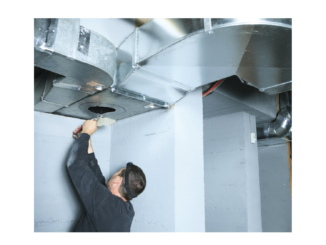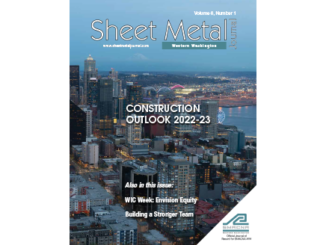
By / Peter Boileau, Chairperson, SMACNA-Western Washington Code & Technical Committee
At our last meeting, the Western Washington Technical and Code Committee reviewed the changes and updates to the new edition of SMACNA’s HVAC Duct Construction Standards, which builds on a duct construction standard that is almost 100 years old. The 3rd edition was published in 2005, so it was appropriate that this industry standard for the fabrication and installation of our duct systems should be updated to include new methods, materials, and technologies. With the release of this new edition, the accompanying press release stated:
“The sheet metal and HVAC industry continues to evolve and adapt to new technologies, and those changes are reflected in this new edition of the HVAC Duct Construction Standards. SMACNA has provided best-in-class information that allows code officials, design professionals, and contractors to deliver safe, modern, and resource-efficient constructed duct systems.
“Technical standards and manuals developed by SMACNA members have worldwide acceptance by the construction and code community, as well as local and national government agencies. SMACNA standards and manuals address all facets of the sheet metal and HVAC industry—including duct construction and installation, indoor air quality, energy recovery, roofing and architectural sheet metal, welding, and commissioning— and advancements are made possible by those in the industry who provide suggestions for improvement based on knowledge, experience, and research.”
As a reference note, when using the 4th edition of the standards, please refer to the preamble on page “x”, immediately preceding the Table of Contents, for a listing of changes and updates to this edition. The committee has listed these updates with page numbers (listed in the manual as “chapter number” followed by a period then “page number”) and descriptions, including our committee’s comments as applicable to assist our members in incorporating these updates into their own duct fabrication specifications and installation standards.
Item 1 – Added information on aerosolized and spray duct sealants: This new information can be found on chapter/page 1.13 under Sections 1.4.9 and 1.4.10. Aerosol based sealant systems are typically applied after the duct is fully assembled and installed, with the sealant blown into the interior of the duct under pressure, where the sealant material migrates to leakage points, collects there, and seals the duct. Although the committee members’ experience with this system is limited, several members pointed out that this method of sealing ducts can adversely affect the operation of any moving parts inside ductwork, specifically damper operation. Spray based sealants, on the other hand, are similar to liquid-applied sealants on the outside of duct seams and joints. This type of sealant can be more convenient to use for small repair or remodel projects and may be more cost-effective in our committee members’ opinions.
Item 2 – Added tables for spiral flat oval duct for positive and negative pressure applications: These tables can be found on pages 3.30 through 3.43 (Tables 3-16 through 3-22). The committee reviewed this information and recommend that users pay particular attention to not only the information in these tables, but also to the explanatory notes on page 3.27. Notes S3.12, S3.14, S3.16, and S3.17 have all been updated from the previous edition of this standard to provide more clarity on how to use the tables to construct this type of ductwork.
Item 3 – Added options for internal supports for spiral flat oval duct: As in previous editions of these duct construction standards, reinforcement of the flat sides of spiral flat oval duct uses the same reinforcement requirements as rectangular duct (per page 3.27, note S3.13). This directs us to chapter 2 for guidance on joint and intermediate duct reinforcement requirements, including the use of internal stiffeners, if desired. Upon the committee’s brief review of this item, we could see no obvious major changes to reinforcing tables/information and therefore this group will reach out to the national task force that developed the 4th edition for more information on what new options are available.
Item 4 – Updated liner requirements to include non-fiberglass liner types: Duct liner material and installation requirements can be found on pages 1.6 through 1.7, and pages 7.13 through 7.21. Based on our brief review, the committee could find no specific alternate materials described (e.g., closed cell foam as an alternative to fiberglass) and the information contained in these sections still describes installation techniques focused on fiberglass liner (e.g., “seal all raw edges with adhesive” which would not be necessary if using closed cell foam). As in item 3 above, we will reach out to the national task force for clarification on this item.
Item 5 – Added information for lined round duct: New information for lining round ductwork is found on pages 7.16 and 7.18, which includes basic installation standards, requirements, requirements for mechanical fastenings for certain duct sizes and orientations, nosing requirements for exposed liner edges, and fastening requirements for lined, single-wall, round duct used in negative pressure applications. There is also significant information under the “Additional Considerations” and “Commentary” sections that in the committee members’ opinions provides excellent detailed information on how to properly use duct liner in round duct systems.
Item 6 – Added details for hangers to better illustrate where hangers are required: Updated information on hanger requirements can be found on pages 5.22 (elbow supports) and 5.23 (branch supports), which include additional support placement requirements spacing dimensions. These details reference Table 5-1 (page 5.7) and now include cable hanging systems as equivalent to straps and/or rods in certain cases.
Item 7 – Updated requirements for flex duct hanger spacing and hanger width: These new requirements can be found on pages 3.52 and 3.53, with some related commentary on page 3.54. The major change for this item is the reduction in hanger spacing from 5 feet to 4 feet. This change was discovered by our committee comparing the 3rd edition requirements to the new, 4th edition requirements, and we would recommend that this change be confirmed by our members as well, as the cost impact could be significant.
Item 8 – Added information for spiral fittings: The committee had a difficult time trying to determine the extent of the added information referenced by the new edition. Subtle changes were noted in the commentary on page 3.2, including some additional verbiage related to double-wall, rigid, round duct and lined, round duct, which is more thoroughly addressed in Item 3 above. As the committee had no additional reference information about what “added information” the 4th edition may have pertaining to spiral fittings, we will have to get clarification from the national task force that developed this edition.
In closing, the notes in the preamble on page “x” state that some inconsistencies were fixed in duct tables addressing TDC/TDF duct systems (including gage, reinforcement, size, and number of rods required) and minor corrections have been made to the round duct tables, as well. The committee recommends that our member companies use the information provided here, plus their own review of this updated standard to confirm they are fabricating and installing ductwork in accordance with this new standard.■



